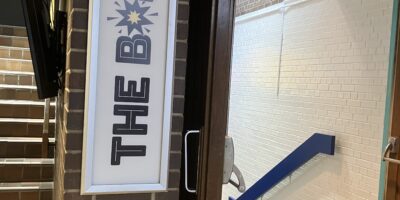One of the many ways students in Engineering (AND other faculties, in this case) can get involved is by joining a design team. UW iGEM is one of those, and I had the pleasure of sitting down with members Teodora Vujovic and Clare Wei to discuss the team, their experiences, and how students can get involved.
What is iGEM?
Teodora: We are Waterloo’s synthetic biology design team. The bulk of what we do is create a solution to an everyday problem, or a bigger problem, using synthetic biology. Now, that can mean a lot of things, so it really depends on what the project is every year. Last year, for example, we created a fusion protein and designed a packed column reactor in order to remove pure copper from electronic wastewater.
Clare: Overall, we take a very interdisciplinary approach. What makes iGEM special is that, rather than just being a traditional engineering design team, we encourage people from all faculties to come together to create something that not only is a synthetic biology solution but can actually be implemented in the real world.
How would you describe the sense of community at iGEM?
Teodora: We have three sub-teams under iGEM: Lab and Design, Math and Modelling, and Human Practices. Depending on what program you’re in or where your interests lie, you might fall into one of those more than the others. I find that the Math and Lab teams especially work really hard together. Everyone on the team is really like-minded and very driven and has similar goals.
Clare: I think the beauty of our community lies not in having the exact same interests, but having a unified passion. To use that diversity of skill sets to create something, I think is what makes our sense of community really special. It’s people coming from really different backgrounds and using their strengths to help create something, and we embrace people’s differences and creativity.
What is your favourite part of iGEM?
Teodora: I’m an Applied Math student, so I think it’s really awesome to be able to apply what I’ve learned in school to a real-life application that we work on and design ourselves. I feel like it’s a really good opportunity to do hands-on learning.
Clare: I feel like the cheesy response is to say that it’s the people, so I’m going to state that there and then move on. Overall, my favourite part of iGEM is the openness to people’s own ideas. All the sub-teams give you the chance to truly apply what you learned in school, but the fact that we don’t stick to one project for the entirety of our time in iGEM means that we get a fresh start every year and we get to use what we’ve learned in past years with a clean slate, without being burdened by previous mistakes in older projects. A lot of the time, if you’re just doing one big project and you mess something up in the beginning, you have to rebuild or restart it from the beginning, so I think it’s fun to have a new project every year.
What have you learned as a member of iGEM?
Clare: Personally, being an engineering student, I’ve found that everyone is very attracted to the technical aspects like software, mechanical design, and industry stuff, and while I do find that fascinating, by taking part in the Human Practices branch I’ve really gotten to explore human factors in synthetic biology as well as the design process and product development, as opposed to just calculus (not that we don’t like calculus). It’s a good way to distance yourself from just the technical stuff while remaining a part of the design process.
Teodora: I really learned about what goes into designing and making something as a part of the Math team, and the depth of possibilities and amount of ways in which you can go about doing it. We really sat down and asked ourselves, “Alright, how can we achieve what we want to achieve?” We laid stuff out and learned things as we went, so I’d say one skill it’s given me is the ability to be really adaptable, especially with COVID-19 hitting and things getting shut down. It’s also taught me to work with so many different people and see how all their different strengths come together to help complete a project. For example, on the Math team, we had a couple of people in Biochemistry, a couple in Computer Science, and a couple in Engineering, so it was really interesting to see how all their strengths came together.
How has iGEM adapted to remote work?
Teodora: We completely lost lab access last year, so one-third of the team had to really scramble to figure out how to transition, which was hard for the Lab team. We transitioned to weekly Zoom meetings for everybody, and the team leads had to make sure that the communication between the three sub-teams was smooth. We also transitioned into doing more bioinformatics and protein modelling to have a proof of concept without actually having to go into the lab.
Clare: Also, the Jamboree, which is the yearly competition that all the iGEM teams at different schools are working towards, was held online this year. Usually, it’s in Boston, and this year it was supposed to be in Paris. We actually send people, but we don’t have enough funds to send everyone, so one benefit of being online was that everyone who wanted to, could attend the Jamboree.
How can new members join iGEM?
Teodora: We always hold a fall info session and a winter info session if you want to learn more, and we sometimes hold other events throughout the year for other reasons if you want to come out and learn more about us. Every year, we have a recruitment cycle in January and it’s a one-year commitment, so usually, applications are due in mid-January and then we do interviews with selected candidates.
Clare: iGEM is a little bit unique in that you actually have to apply to join, and there are pros and cons to that. The pros are definitely that the people who apply end up staying because they’ve already put in the effort to go through the application process, but the cons are that we’re missing out on people who were just busy at the time when they had to apply.
The team can also be contacted by emailing uwigem@gmail.com.





Leave a Reply